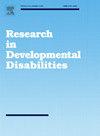Developmental coordination disorder and cerebral visual impairment: What is the association?
IF 2.9
2区 医学
Q1 EDUCATION, SPECIAL
引用次数: 0
Abstract
Introduction
Children with Developmental Coordination Disorder (DCD) experience impairments beyond motor planning, affecting visual perceptual and visual-motor integration abilities, similar to children with Cerebral Visual Impairment (CVI), making it challenging to distinguish between the two conditions. This study aimed to identify convergences and divergences in the clinical, neuropsychological, and functional vision-related skills of children with DCD and CVI.
Methods
An assessment of the neuropsychological profile (cognitive, visual cognitive, and motor coordination skills) and visual acuity were conducted on 65 children with DCD (mean age: 8 years, 1 month; SD: 1 year, 6 months) and 35 children with CVI (mean age: 8 years, 5 months; SD: 2 years, 6 months) and compared between the two groups. The CVI-Inventory (CVI-I) was used to evaluate functional vision-related problems and to cluster subjects.
Results
Visual attention, visual perception, global motor coordination, and visual constructive scores didn’t differ between the two groups even if children with CVI showed lower scores in the intellectual, visual, visual cognitive, and motor abilities. The overlap index confirmed an overlap on most of the variables considered. Six discriminative questions from the CVI-I clustered subjects into two groups: the first, with more children with CVI (62.9 %) and a more compromised neuropsychological profile, and the second, with more children with DCD (86.7 %).
Conclusion
DCD and CVI share both similarities and differences. Low visual acuity, low IQ scores, severe visual-motor integration challenges, and difficulties with fine motor and balance skills should prompt clinicians to screen for CVI in children with DCD. Specific functional vision-related problems can assist in this differentiation.
发育性协调障碍与脑性视觉障碍:两者有何关联?
与脑性视觉障碍(CVI)儿童类似,患有发育性协调障碍(DCD)的儿童会经历运动规划以外的障碍,影响视觉感知和视觉-运动整合能力,因此很难区分这两种情况。本研究旨在确定DCD和CVI儿童在临床、神经心理学和功能性视觉相关技能方面的趋同和差异。方法对65例DCD患儿(平均年龄8岁1个月;SD: 1岁6个月)和35例CVI患儿(平均年龄:8岁5个月;SD: 2年,6个月),两组比较。CVI-Inventory (CVI-I)用于评估功能性视觉相关问题并对受试者进行聚类。结果CVI患儿在智力、视觉、视觉认知和运动能力方面得分较低,但在视觉注意、视觉感知、整体运动协调和视觉建设性得分方面两组间无显著差异。重叠指数证实了所考虑的大多数变量的重叠。来自CVI- i的6个判别问题将受试者分为两组:第一组有更多的CVI儿童(62.9 %)和更受损的神经心理特征,第二组有更多的DCD儿童(86.7 %)。结论dcd与CVI既有相似之处,也有不同之处。低视力、低智商、严重的视觉运动整合挑战、精细运动和平衡技能的困难应该促使临床医生筛查患有DCD的儿童的CVI。特定的功能性视觉相关问题有助于这种区分。
本文章由计算机程序翻译,如有差异,请以英文原文为准。
求助全文
约1分钟内获得全文
求助全文
来源期刊

Research in Developmental Disabilities
Multiple-
CiteScore
5.50
自引率
6.50%
发文量
178
期刊介绍:
Research In Developmental Disabilities is aimed at publishing original research of an interdisciplinary nature that has a direct bearing on the remediation of problems associated with developmental disabilities. Manuscripts will be solicited throughout the world. Articles will be primarily empirical studies, although an occasional position paper or review will be accepted. The aim of the journal will be to publish articles on all aspects of research with the developmentally disabled, with any methodologically sound approach being acceptable.
 求助内容:
求助内容: 应助结果提醒方式:
应助结果提醒方式:


